 We continue to live through incredibly turbulent times. In the past decade or so we have experienced a global financial crisis, a global health emergency, seen the UK’s departure from the European Union, and witnessed increasing levels of geopolitical tension and conflict. Add to this the effects from the climate emergency and it easy to see why the issue of economic uncertainty is so important when thinking about a country’s economic prospects.
We continue to live through incredibly turbulent times. In the past decade or so we have experienced a global financial crisis, a global health emergency, seen the UK’s departure from the European Union, and witnessed increasing levels of geopolitical tension and conflict. Add to this the effects from the climate emergency and it easy to see why the issue of economic uncertainty is so important when thinking about a country’s economic prospects.
In this blog we consider how we can capture this uncertainty through a World Uncertainty Index and the ways by which economic uncertainty impacts on the macroeconomic environment.
World Uncertainty Index
Hites Ahir, Nicholas Bloom and Davide Furceri have constructed a measure of uncertainty known as the World Uncertainty Index (WUI). This tracks uncertainty around the world using the process of ‘text mining’ the country reports produced by the Economist Intelligence Unit. The words searched for are ‘uncertain’, ‘uncertainty’ and ‘uncertainties’ and a tally is recorded based on the number of times they occur per 1000 words of text. To produce the index this figure is then multiplied up by 100 000. A higher number therefore indicates a greater level of uncertainty. For more information on the construction of the index see the 2022 article by Ahir, Bloom and Furceri linked below.
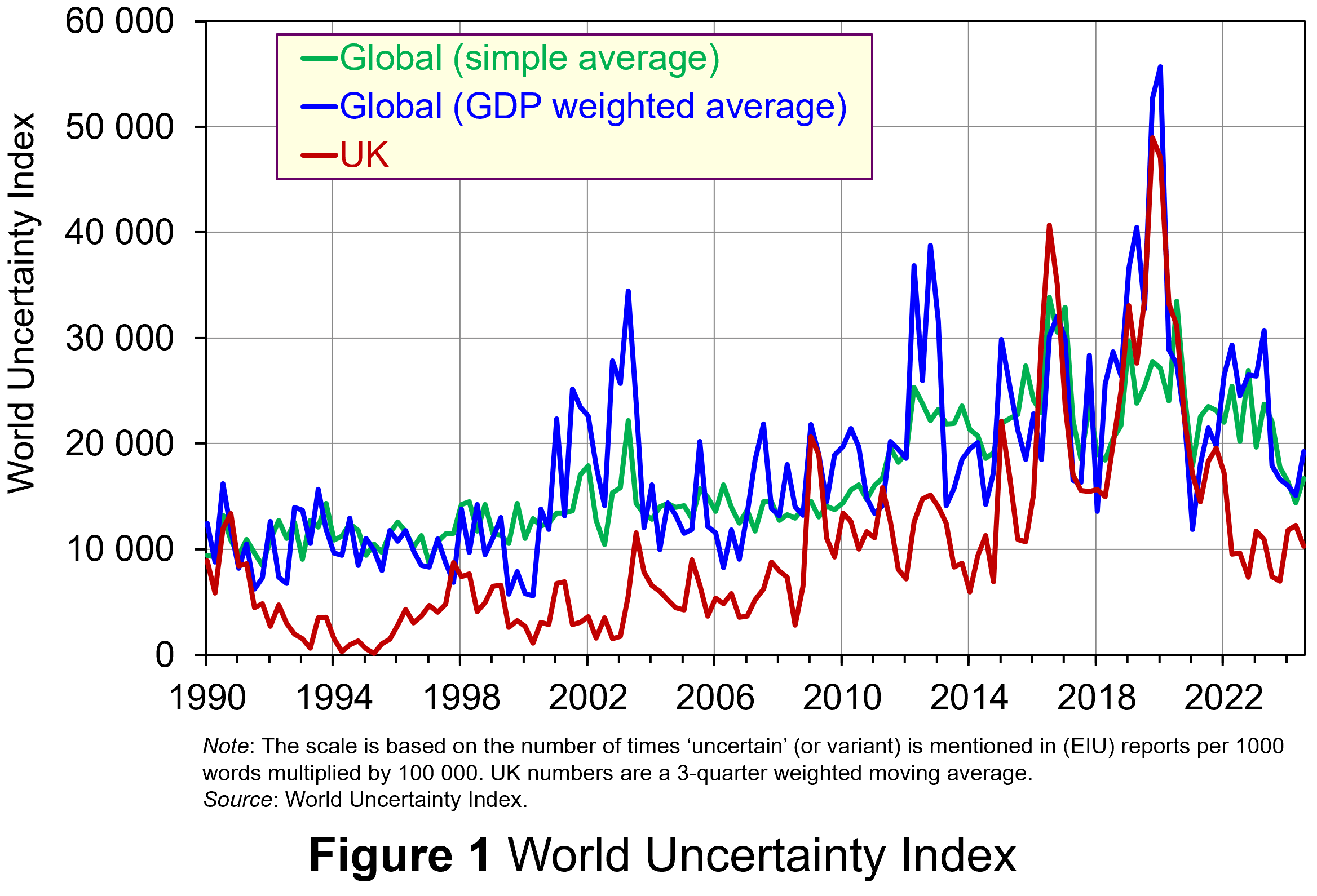 Figure 1 (click here for a PowerPoint) shows the WUI both globally and in the UK quarterly since 1991. The global index covers 143 countries and is presented as both a simple average and a GDP weighted average. The UK WUI is also shown. This is a three-quarter weighted average, the authors’ preferred measure for individual countries, where increasing weights of 0.1, 0.3 and 0.6 are used for the three most recent quarters.
Figure 1 (click here for a PowerPoint) shows the WUI both globally and in the UK quarterly since 1991. The global index covers 143 countries and is presented as both a simple average and a GDP weighted average. The UK WUI is also shown. This is a three-quarter weighted average, the authors’ preferred measure for individual countries, where increasing weights of 0.1, 0.3 and 0.6 are used for the three most recent quarters.
From Figure 1 we can see how the level of uncertainty has been particularly volatile over the past decade or more. Events such as the sovereign debt crisis in parts of Europe in the early 2010s, the Brexit referendum in 2016, the COVID-pandemic in 2020–21 and the invasion of Ukraine in 2022 all played their part in affecting uncertainty domestically and internationally.
Uncertainty, risk-aversion and aggregate demand
Now the question turns to how uncertainty affects economies. One way of addressing this is to think about ways in which uncertainty affects the choices that people and businesses make. In doing so, we could think about the impact of uncertainty on components of aggregate demand, such as household consumption and investment, or capital expenditures by firms.
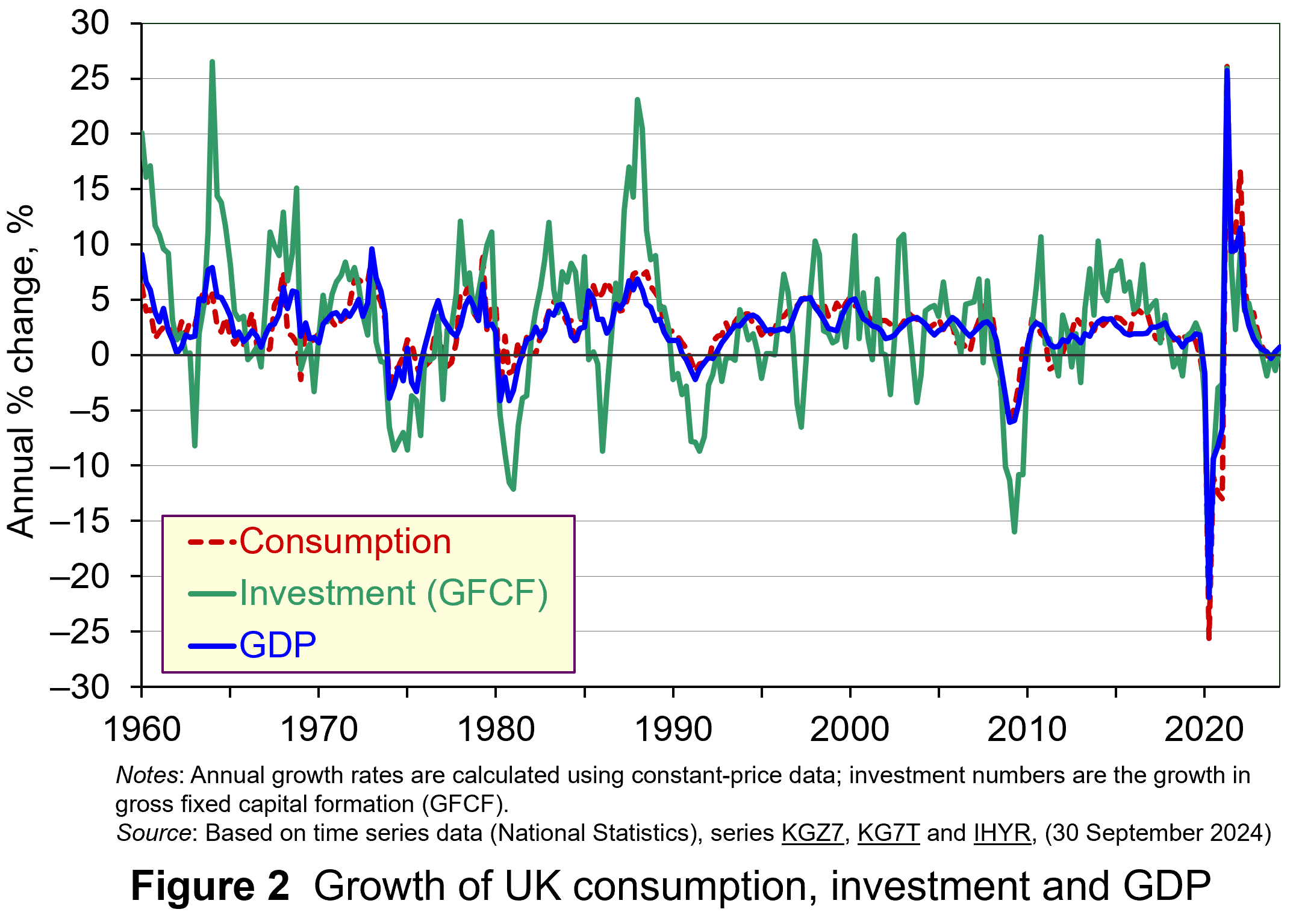 As Figure 2 shows (click here for a PowerPoint), investment is particularly volatile, and much more so than household spending. Some of this can be attributed to the ‘lumpiness’ of investment decisions since these expenditures tend to be characterised by indivisibility and irreversibility. This means that they are often relatively costly to finance and are ‘all or nothing’ decisions. In the context of uncertainty, it can make sense therefore for firms to wait for news that makes the future clearer. In this sense, we can think of uncertainty rather like a fog that firms are peering through. The thicker the fog, the more uncertain the future and the more cautious firms are likely to be.
As Figure 2 shows (click here for a PowerPoint), investment is particularly volatile, and much more so than household spending. Some of this can be attributed to the ‘lumpiness’ of investment decisions since these expenditures tend to be characterised by indivisibility and irreversibility. This means that they are often relatively costly to finance and are ‘all or nothing’ decisions. In the context of uncertainty, it can make sense therefore for firms to wait for news that makes the future clearer. In this sense, we can think of uncertainty rather like a fog that firms are peering through. The thicker the fog, the more uncertain the future and the more cautious firms are likely to be.
The greater caution that many firms are likely to adopt in more uncertain times is consistent with the property of risk-aversion that we often attribute to a range of economic agents. When applied to household spending decisions, risk-aversion is often used to explain why households are willing to hold a buffer stock of savings to self-insure against unforeseen events and their future financial outcomes being worse than expected. Hence, in more uncertain times households are likely to want to increase this buffer further.
 The theory of buffer-stock saving was popularised by Christopher Carroll in 1992 (see link below). It implies that in the presence of uncertainty, people are prepared to consume less today in order to increase levels of saving, pay off existing debts, or borrow less relative to that in the absence of uncertainty. The extent of the buffer of financial wealth that people want to hold will depend on their own appetite for risk, the level of uncertainty, and the moderating effect from their own impatience and, hence, present bias for consuming today.
The theory of buffer-stock saving was popularised by Christopher Carroll in 1992 (see link below). It implies that in the presence of uncertainty, people are prepared to consume less today in order to increase levels of saving, pay off existing debts, or borrow less relative to that in the absence of uncertainty. The extent of the buffer of financial wealth that people want to hold will depend on their own appetite for risk, the level of uncertainty, and the moderating effect from their own impatience and, hence, present bias for consuming today.
Risk aversion is consistent with the property of diminishing marginal utility of income or consumption. In other words, as people’s total spending volumes increase, their levels of utility or satisfaction increase but at an increasingly slower rate. It is this which explains why individuals are willing to engage with the financial system to reallocate their expected life-time earnings and have a smoother consumption profile than would otherwise be the case from their fluctuating incomes.
Yet diminishing marginal utility not only explains consumption smoothing, but also why people are willing to engage with the financial system to have financial buffers as self-insurance. It explains why people save more or borrow less today than suggested by our base-line consumption smoothing model. It is the result of people’s greater dislike (and loss of utility) from their financial affairs being worse than expected than their like (and additional utility) from them being better than expected. This tendency is only likely to increase the more uncertain times are. The result is that uncertainty tends to lower household consumption with perhaps ‘big-ticket items’, such as cars, furniture, and expensive electronic goods, being particularly sensitive to uncertainty.
Uncertainty and confidence
Uncertainty does not just affect risk; it also affects confidence. Risk and confidence are often considered together, not least because their effects in generating and transmitting shocks can be difficult to disentangle.
We can think of confidence as capturing our mood or sentiment, particularly with respect to future economic developments. Figure 3 plots the Uncertainty Index for the UK alongside the OECD’s composite consumer and business confidence indicators. Values above 100 for the confidence indicators indicate greater confidence about the future economic situation and near-term business environment, while values below 100 indicate pessimism towards the future economic and business environments.
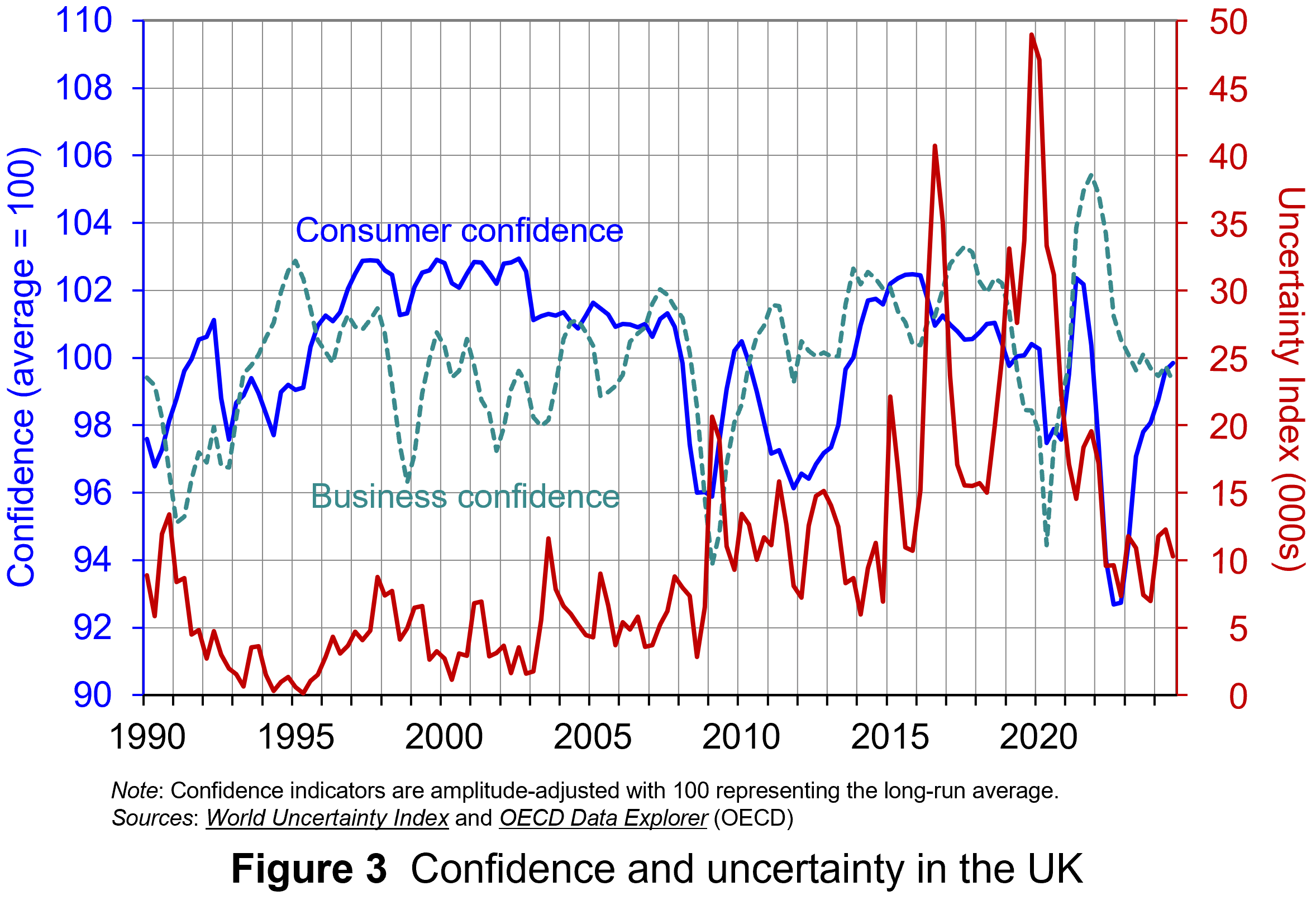 Figure 3 suggests that the relationship between confidence and uncertainty is rather more complex than perhaps is generally understood (click here for a PowerPoint). Haddow, Hare, Hooley and Shakir (see link below) argue that the evidence tends to point to changes in uncertainty affecting confidence, but with less evidence that changes in confidence affect uncertainty.
Figure 3 suggests that the relationship between confidence and uncertainty is rather more complex than perhaps is generally understood (click here for a PowerPoint). Haddow, Hare, Hooley and Shakir (see link below) argue that the evidence tends to point to changes in uncertainty affecting confidence, but with less evidence that changes in confidence affect uncertainty.
To illustrate this, consider the global financial crisis of the late 2000s. The argument can be made that the heightened uncertainty about future prospects for households and businesses helped to erode their confidence in the future. The result was that people and businesses revised down their expectations of the future (pessimism). However, although people were more pessimistic about the future, this was more likely to have been the result of uncertainty rather than the cause of further uncertainty.
Conclusion
For economists and policymakers alike, indicators of uncertainty, such as the Ahir, Bloom and Furceri World Uncertainty Index, are invaluable tools in understanding and forecasting behaviour and the likely economic outcomes that follow. Some uncertainty is inevitable, but the persistence of greater uncertainty since the global financial crisis of the late 2000s compares quite starkly with the relatively lower and more stable levels of uncertainty seen from the mid-1990s up to the crisis. Hence the recent frequency and size of changes in uncertainty show how important it to understand how uncertainty effects transmit through economies.
Academic papers
- The World Uncertainty Index
National Bureau of Economic Research, Working Paper 29763, Hites Ahir, Nicholas Bloom and Davide Furceri (February 2022)
- The Buffer-Stock Theory of Saving: Some Macroeconomic Evidence
Brookings Papers on Economic Activity, Christopher D Carroll (Vol 2, 1992)
- Macroeconomic uncertainty: what is it, how can we measure it and why does it matter?
Bank of England Quarterly Bulletin, 2013 Q2, Abigail Haddow, Chris Hare, John Hooley and Tamarah Shakir (13/6/13)
Articles
Data
Questions
- (a) Explain what is meant by the concept of diminishing marginal utility of consumption.
(b) Explain how this concept helps us to understand both consumption smoothing and the motivation to engage in buffer-stock saving.
- Explain the distinction between confidence and uncertainty when analysing macroeconomic shocks.
- Discuss which types of expenditures you think are likely to be most susceptible to uncertainty shocks.
- Discuss how economic uncertainty might affect productivity and the growth of potential output.
- How might the interconnectedness of economies affect the transmission of uncertainty effects through economies?
 In recent months there has been growing uncertainty across the global economy as to whether the US economy was going to experience a ‘hard’ or ‘soft landing’ in the current business cycle – the repeated sequences of expansion and contraction in economic activity over time. Announcements of macroeconomic indicators have been keenly anticipated for signals about how quickly the US economy is slowing.
In recent months there has been growing uncertainty across the global economy as to whether the US economy was going to experience a ‘hard’ or ‘soft landing’ in the current business cycle – the repeated sequences of expansion and contraction in economic activity over time. Announcements of macroeconomic indicators have been keenly anticipated for signals about how quickly the US economy is slowing.
Such heightened uncertainty is a common feature of late-cycle slowing economies, but uncertainty now has been exacerbated because it has been a while since developed economies have experienced a business cycle like the current one. The 21st century has been characterised by low inflation, low interest rates and recessions caused by various types of crises – a stock market crisis (2001), a banking crisis (2008) and a global pandemic (2020). In contrast, the current cycle is a throwback to the 20th century. The high inflation and the ensuing increases in interest rates have produced a business cycle which echoes the 1970s. Therefore, few investors have experience of such economic conditions.
The focus for investors during this stage of the cycle is when the slowing economy will reach the minimum. They will also be concerned with the depth of the slowdown: will there still be some growth in income, albeit low; or will the trough be severe enough to produce a recession, and, if so, how deep? Given uncertainty around the length and magnitude of business cycles, this leads to greater risk aversion among investors. This affects reactions to announcements of leading and lagging macroeconomic indicators.
This blog examines what sort of economic conditions we should expect in a late-cycle economy. It analyses the impact this has had on investor behaviour and the ensuing dynamics observed in financial markets in the USA.
The Business Cycle
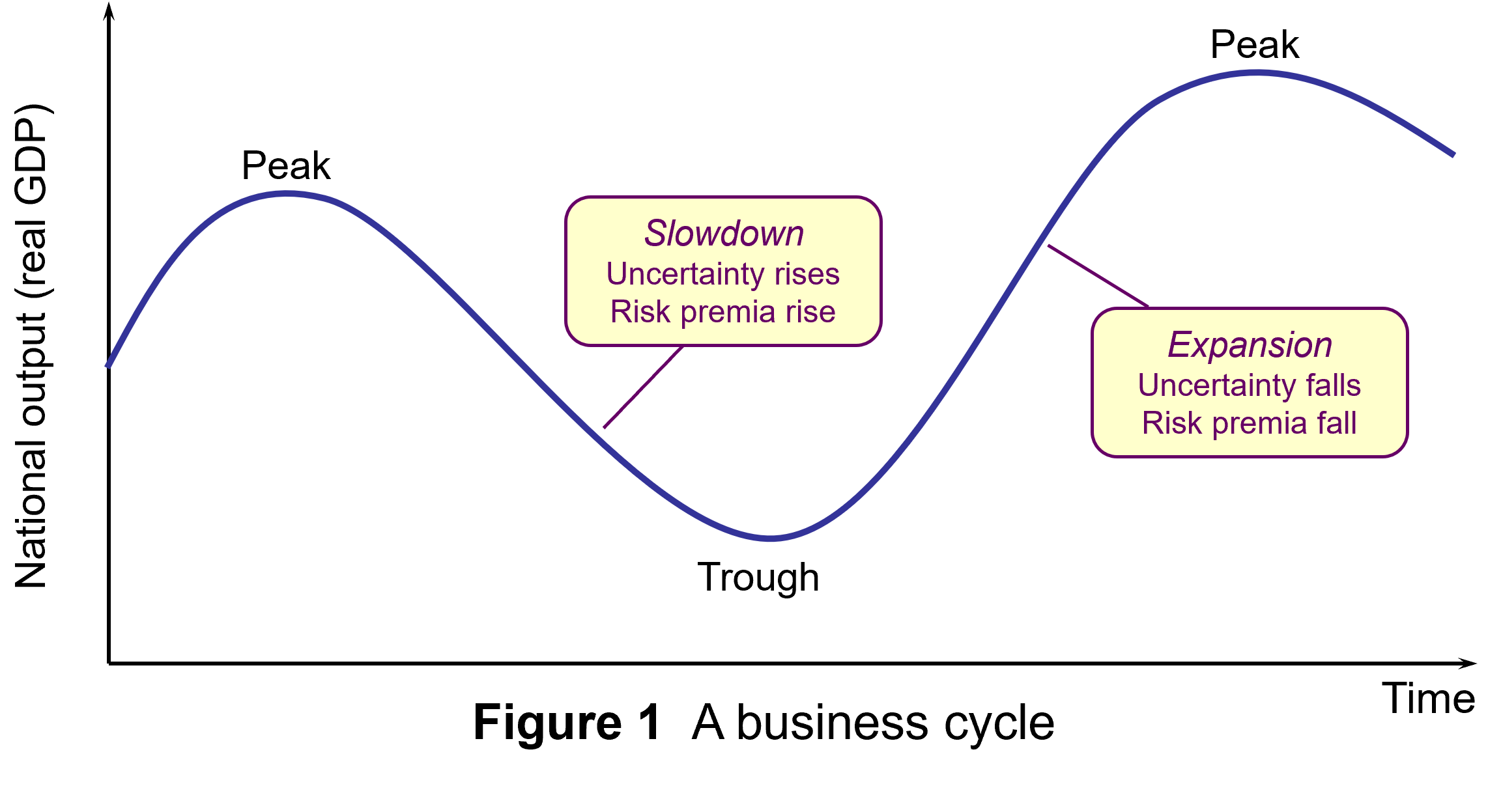
The business cycle refers to repeated sequences of expansion and contraction (or slowdown) in economic activity over time. Figure 1 illustrates a typical cycle. Typically, these sequences include four main stages. In each one there are different effects on consumer and business confidence:
- Expansion: During this stage, the economy experiences growth in GDP, with incomes and consumption spending rising. Business and consumer confidence are high. Unemployment is falling.
- Peak: This is the point at which the economy reaches its maximum output, but growth has ceased (or slowed). At this stage, inflationary pressures peak as the economy presses against potential output. This tends to result in tighter monetary policy (higher interest rates).
- Slowdown: The higher interest rates raise the cost of borrowing and reduce consumption and investment spending. Consumption and incomes both slow or fall. (Figure 1 illustrates the severe case of falling GDP (negative growth) in this stage.) Unemployment starts rising.
- Trough: This is the lowest point of the cycle, where economic activity bottoms out and the economy begins to recover. This can be associated with slow but still rising national income (a soft landing) or national income that has fallen (a hard landing, as shown in Figure 1).
While business cycles are common enough to enable such characterisation of their temporal pattern, their length and magnitude are variable and this produces great uncertainty, particularly when cycles approach peaks and troughs.
 As an economy’s cycle approaches a trough, such as US economy’s over the past few months, uncertainty is exacerbated. The high interest rates used to tackle inflation will have increased borrowing costs for businesses and consumers. Access to credit may have become more restricted. Profit margins are reduced, especially for industrial sectors sensitive to the business cycle, reducing expected cash flows.
As an economy’s cycle approaches a trough, such as US economy’s over the past few months, uncertainty is exacerbated. The high interest rates used to tackle inflation will have increased borrowing costs for businesses and consumers. Access to credit may have become more restricted. Profit margins are reduced, especially for industrial sectors sensitive to the business cycle, reducing expected cash flows.
The combination of these factors can increase the risk of a recession, producing greater volatility in financial markets. This manifests itself in increased risk aversion among investors.
Utility theory suggests that, in general, investors will exhibit loss aversion. This means that they do not like bearing risk, fearing that the return from an investment may be less than expected. In such circumstances, investors need to be compensated for bearing risk. This is normally expressed in terms of expected financial return. To bear more risk, investors require higher levels of return as compensation.
As perceptions of risk change through the business cycle, so this will change the return investors will require from the financial instruments they hold. Perceived higher risk raises the return investors will require as compensation. Conversely, lower perceived risk decreases the return investors expect as compensation.
Investors’ expected rate of return is manifested in the discount rate that they use to value the anticipated cash flows from financial instruments in discounted cash flow (DCF) analysis. Equation 1 is the algebraic expression of the present-value discounted series of cash flows for financial instruments:

Where:
V = present value
C = anticipated cash flows in each of time periods 1, 2, 3, etc.
r = expected rate of return
For fixed-income debt securities, the cash flow is constant, while for equity securities (shares), expectations regarding cash flows can change.
Slowing economies and risk aversion
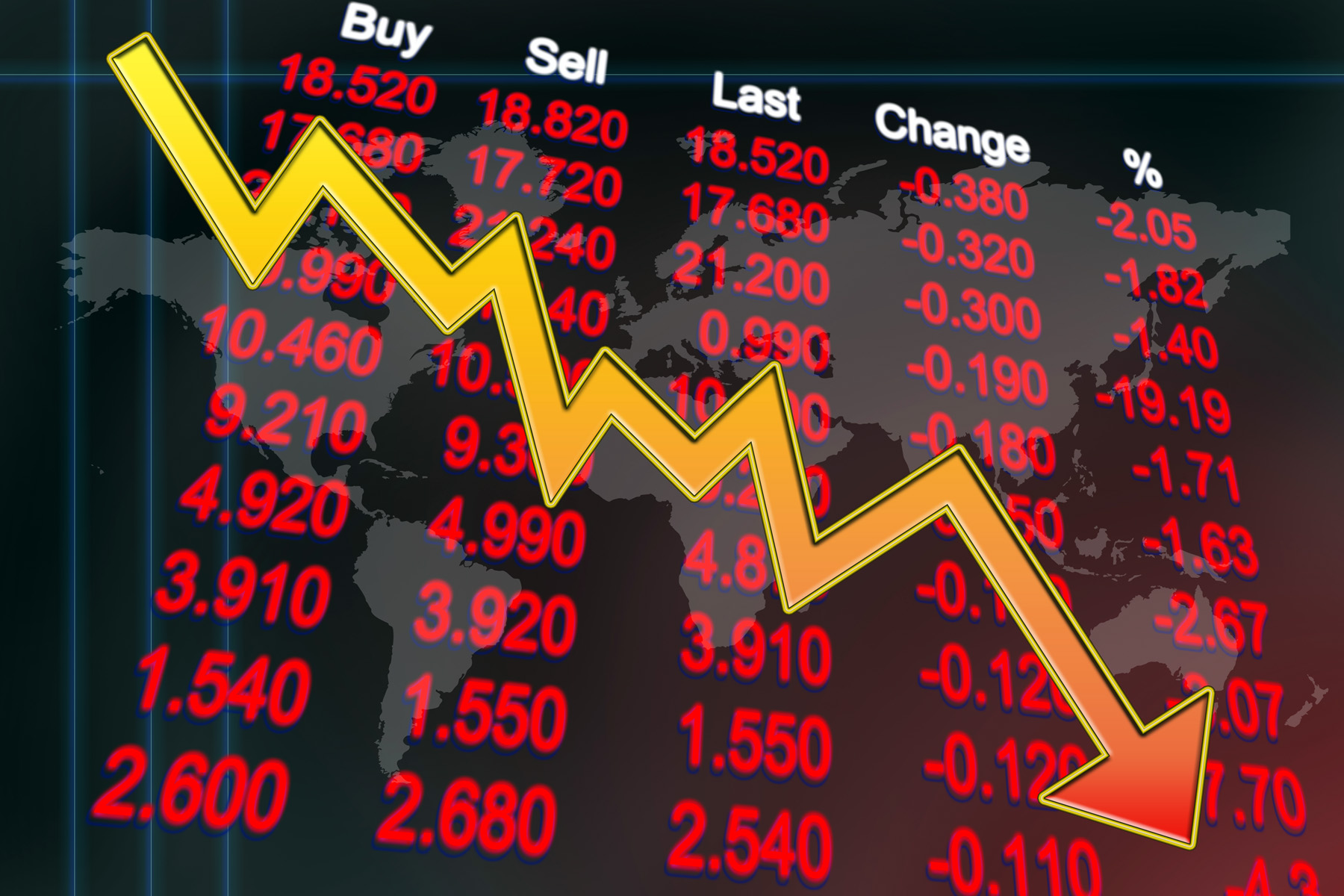 In a slowing economy, with great uncertainty about the scale and timing of the bottom of the cycle, investors become more risk averse about the prospects of firms. This this leads to higher risk premia for financial instruments sensitive to a slowdown in economic activity.
In a slowing economy, with great uncertainty about the scale and timing of the bottom of the cycle, investors become more risk averse about the prospects of firms. This this leads to higher risk premia for financial instruments sensitive to a slowdown in economic activity.
This translates into a higher expected return and higher discount rate used in the valuation of these instruments (r in equation 1). This produces decreases in perceived value, decreased demand and decreased prices for these financial instruments. This can be observed in the market dynamics for these instruments.
First, there may be a ‘flight to safety’. Investors attach a higher risk premium to risker financial instruments, such as equities, and seek a ‘safe-haven’ for their wealth. Therefore, we should observe a reorientation from more risky to less risky assets. Demand for equities falls, while demand for safer assets, such as government bonds and gold, rises.
There is some evidence for this behaviour as uncertainty about the US economic outlook has increased. Gold, long seen as a hedge against market decline, is at record highs. US Government bond prices have risen too.
To analyse whether this may be a flight to safety, I analysed the correlation between the daily US government bond price (5-year Treasury Bill) and share prices represented by the two more significant stock market indices in the USA: the S&P 500 and the Nasdaq Composite. I did this for two different time periods. Table 1 shows the results. Panel (a) shows the correlation coefficients for the period between 1 May 2024 and 31 July 2024; Panel (b) shows the correlation coefficients for the period between 1 August 2024 and 9 September 2024.
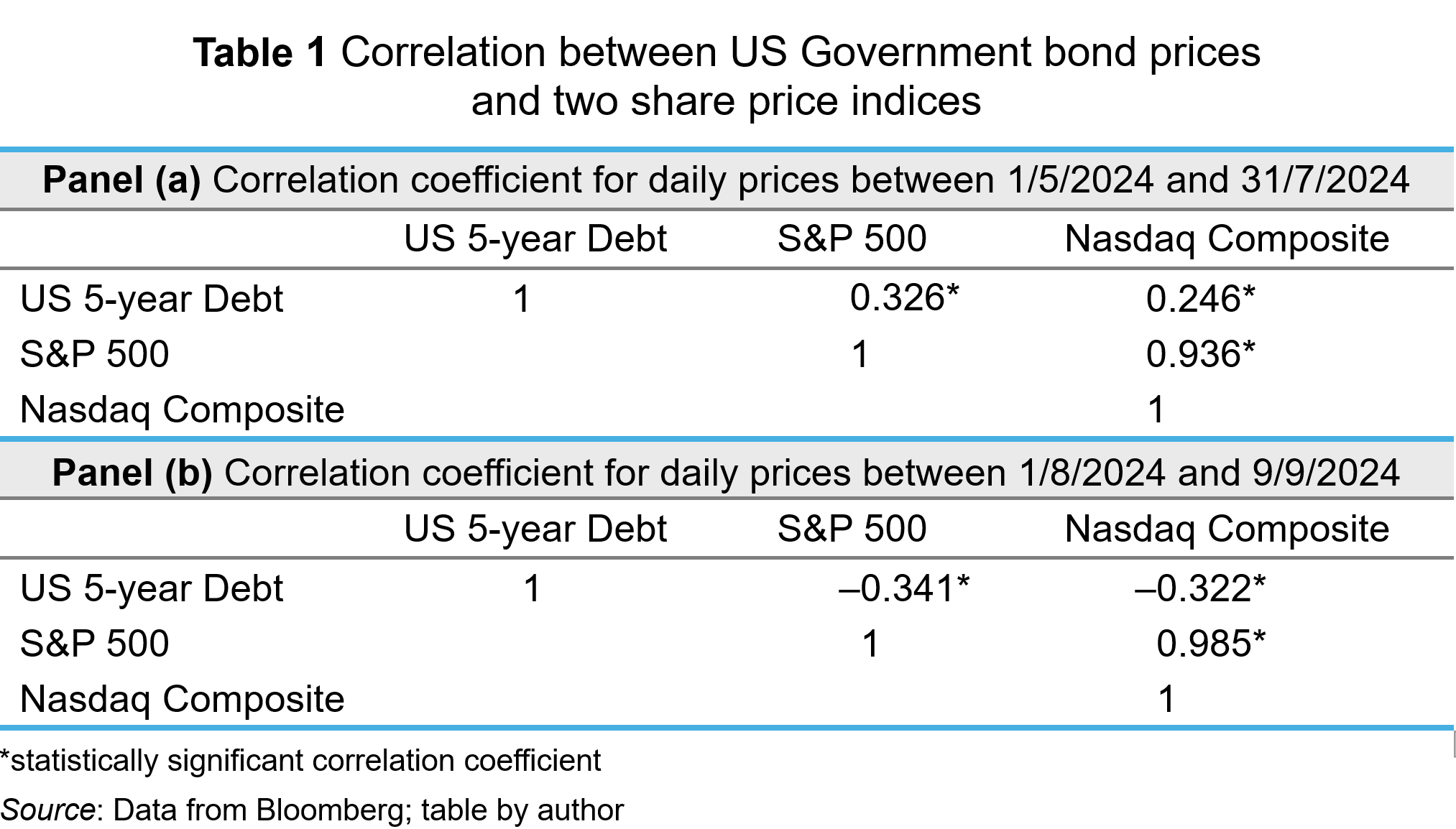
In the period between May and July 2024, the 5-year Treasury Bill and share price indices had significantly positive correlations. When share prices rose, the Treasury Bill’s price rose; when share prices fell, the bill’s price fell. During that period, expectations about falling interest rates dominated valuations and that effected the valuations of all financial instruments in the same way – lower expected interest rates reduce the opportunity cost of holding instruments and reduces the expected rates of return. Hence, the discount rate applied to cash flows is reduced, and present value rises. The opposite happens when macroeconomic indicators suggest that interest rates will stay high (ceteris paribus).
As the summer proceeded, worries about a ‘hard landing’ began to concern investors. A weak jobs report in early August particularly exercised markets, producing a ‘flight to safety’. Greater risk aversion among investors meant that they expect a higher return from equities. This reduced perceived value, reducing demand and price (ceteris paribus). To insulate themselves from higher risk, investors bought safer assets, like government bonds, thereby pushing up their prices. This behaviour was consistent with the significant negative correlation observed between US government debt prices and the S&P 500 and Nasdaq indices in Panel (b).
Another signal of increased risk aversion among investors is ‘sector rotation’ in their equity portfolios. Increased risk aversion among investors will lead them to divest from ‘cyclical’ companies. Such companies are in industrial sectors which are more sensitive to the changing economic conditions across the business cycle – consumer discretionary and communication services sectors, for example. To reduce their exposure to risk, investors will switch to ‘defensive’ sectors – those less sensitive to the business cycle. Examples include consumer staples and utility sectors.
Cyclical sectors will suffer a greater adverse impact on their cash flows and risk in a slowing economy. Consequently, investors expect higher return as compensation. This reduces the value of those shares. Demand for them falls, depressing their price. In contrast, defensive sectors will be valued more. They will see an increase in demand and price. This sector rotation seems to have happened in August (2024). Figure 2 shows the percentage change between 1 August and 9 September 2024 in the S&P 500 index and four sector indices, comprising companies from the communication services, consumer discretionary, consumer staples and utilities sectors.
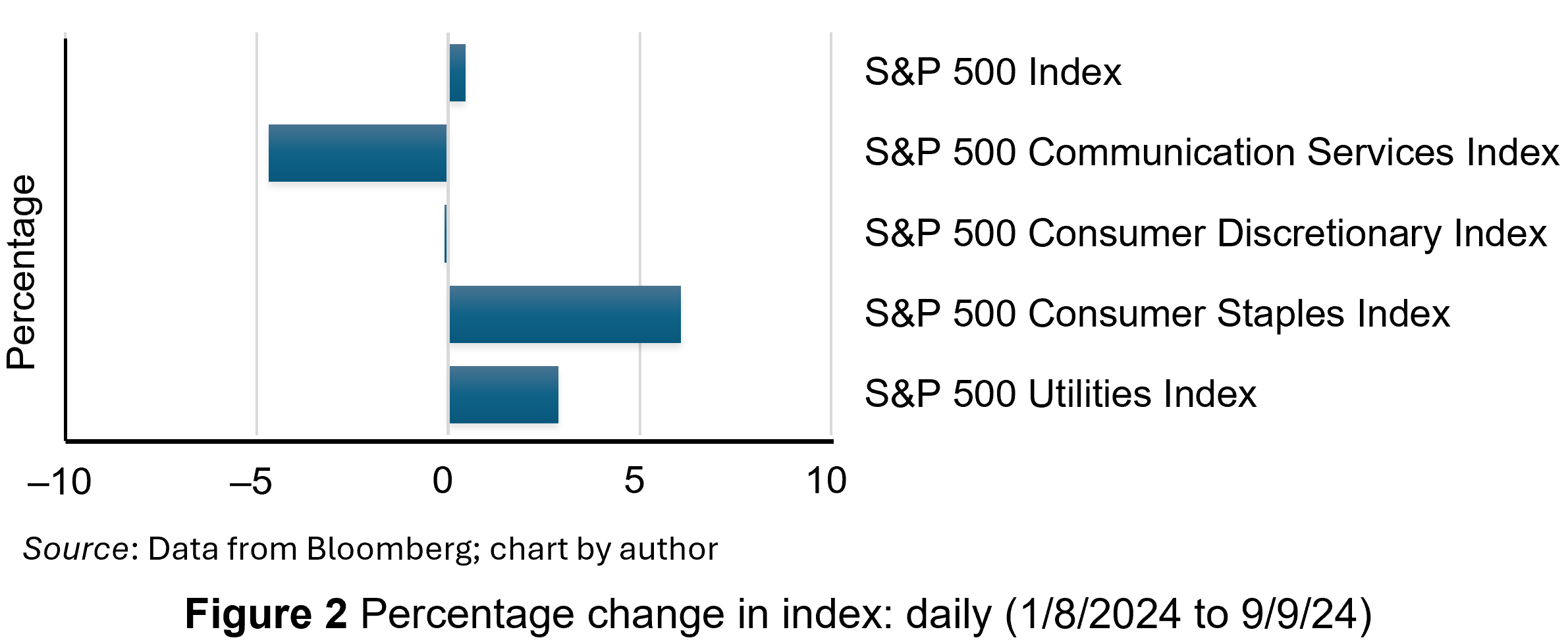
Overall, the S&P 500 index was slightly higher, as shown by the first bar in the chart. However, while the cyclical sectors experienced decreases in their share prices, particularly communication services, the defensive companies experienced large price increases – nearly 3% for utilities and over 6% for consumer staples.
Conclusion
Economies experience repeated sequences of expansion and contraction in economic activity over time. At the moment, the US economy is approaching the end of its current slowing phase. Increased uncertainty is a common feature of late-cycle economies and this manifests itself in heightened risk aversion among investors. This produces certain dynamics which have been observable in US debt and equity markets. This includes a ‘flight to safety’, with investors divesting risky financial instruments in favour of safer ones, such as US government debt securities and gold. Also, investors have been reorientating their equity portfolios away from cyclicals and towards defensive securities.
Articles
- America’s recession signals are flashing red. Don’t believe them
The Economist (22/8/24)
- The most well-known recession indicator stopped flashing red, but now another one is going off
CNN, Elisabeth Buchwald (13/9/24)
- World’s largest economy will still achieve soft landing despite rising unemployment, most analysts believe
Financial Times, Claire Jones, Delphine Strauss and Martha Muir (6/8/24)
- We’re officially on slowdown watch
Financial Times, Robert Armstrong and Aiden Reiter (30/8/24)
- Anatomy of a rout
Financial Times, Robert Armstrong and Aiden Reiter (6/8/24)
- Reasons why investors need to prepare for a US recession
Financial Times, Peter Berezin (5/9/24)
- Business Cycle: What It Is, How to Measure It, and Its 4 Phases
Investopedia, Lakshman Achuthan (6/6/24)
- Risk Averse: What It Means, Investment Choices, and Strategies
Investopedia, James Chen (5/8/24)
Data
Questions
- What is risk aversion? Sketch an indifference curve for a risk-averse investor, treating expected return and risk as two-characteristics of a financial instrument.
- Show what happens to the slope of the indifference curve if the investor becomes more risk averse.
- Using demand and supply analysis, illustrate and explain the impact of a flight to safety on the market for (i) company shares and (ii) US government Treasury Bills.
- Use economic theory to explain why the consumer discretionary sector may be more sensitive than the consumer staples sector to varying incomes across the economic cycle.
- Research the point of the economic cycle that the US economy has reached as you read this blog. What is the relationship between bond and equity prices? Which sectors have performed best in the stock market?
 On 12 February, it was announced that The Body Shop UK was entering administration. With 199 shops across the country, if this leads to the collapse of the business, some 2000 jobs will be lost. The business has been struggling since 2020 and poor sales this last Christmas led the new owners, the pan-European alternative investment firm, Aurelius, to appoint administrators.
On 12 February, it was announced that The Body Shop UK was entering administration. With 199 shops across the country, if this leads to the collapse of the business, some 2000 jobs will be lost. The business has been struggling since 2020 and poor sales this last Christmas led the new owners, the pan-European alternative investment firm, Aurelius, to appoint administrators.
This could potentially begin an insolvency process that could result in the closure of some or all of the shops. This would spell the end of an iconic brand that, since its founding in 1976, has been associated with natural, ethically sourced and environmentally friendly products. Aurelius has already sold The Body Shop business in most of mainland Europe and in parts of Asia to an unnamed buyer. It is unclear what will happen to the approximately 2800 stores and 8000 employees in 70 countries outside the UK.
Origins of The Body Shop1
 The Body Shop was founded in 1976 and shot to fame in the 1980s. It stood for environmental awareness and an ethical approach to business. But its success had as much to do with what it sold as what it stood for. It sold natural cosmetics – Raspberry Ripple Bathing Bubbles and Camomile Shampoo – products that proved immensely popular with consumers.
The Body Shop was founded in 1976 and shot to fame in the 1980s. It stood for environmental awareness and an ethical approach to business. But its success had as much to do with what it sold as what it stood for. It sold natural cosmetics – Raspberry Ripple Bathing Bubbles and Camomile Shampoo – products that proved immensely popular with consumers.
Its profits increased from a little over £1m in 1985 (€1.7m) to approximately £65m (€77.5m) in 2012. Although profits then slipped, falling to €65.3m in 2014 and €54.8m in 2015, its profit growth in new markets over that same period was 12.4%.
Sales revenue, meanwhile, grew even more dramatically, from £4.9m in 1985 to approximately €967.2m in 2015. By 2015, Body Shop International had over 3100 stores, operating in 61 countries.
What made this success so remarkable is that The Body Shop did virtually no advertising. Its promotion stemmed largely from the activities and environmental campaigning of its founder, Anita Roddick, and the company’s uncompromising claim that it sold only ‘green’ products and conducted its business operations with high ethical standards. It actively supported green causes such as saving whales and protecting rainforests, and it refused to allow its products to be tested on animals. Perhaps most surprising in the world of big business at the time was its high-profile initiative ‘trade not aid’, whereby it claimed to pay ‘fair’ prices for its ingredients, especially those supplied by people in developing countries who were open to exploitation by large companies.
 The growth strategy of The Body Shop focused upon developing a distinctive and highly innovative product range, and at the same time identifying these products with major social issues of the day, such as the environment and animal rights.
The growth strategy of The Body Shop focused upon developing a distinctive and highly innovative product range, and at the same time identifying these products with major social issues of the day, such as the environment and animal rights.
Its initial expansion was based on a process of franchising, where individuals opened Body Shops which were then supplied by the company with its range of just 19 products. Then, in 1984 the company went public. Following its flotation, the share price rose from just 5p to a high of 370p in 1992.
In the 1990s, however, sales growth was less rapid. By 1998, earnings had collapsed by 90% and the share price fell to 117p. Shareholders forced Anita Roddick to step down as Chief Executive, but for a while she and her husband remained as co-chairs. In 2002, they stepped down as co-chairs, by which time profits had fallen to £20.4m. In 2003 she was awarded in knighthood and became Dame Anita Roddick. Sales then grew rapidly from 2004 to 2006 from €553m to €709m.
Acquisition of The Body Shop by L’Oréal
A dramatic event, however, occurred in 2006 when The Body Shop was sold to the French cosmetics giant, L’Oréal, which was 26% owned by Nestlé, The event resulted in the magazine Ethical Consumer downgrading The Body Shop’s ethical rating from 11 out of 20 to a mere 2.5 and calling for a boycott of the company. Three weeks after the sale, the daily BrandIndex recorded an 11 point drop in The Body Shop’s consumer satisfaction rating from 25 to 14.
There were several reasons for this. L’Oréal’s animal-testing policies conflicted with those of The Body Shop and L’Oréal was accused of being involved in price-fixing with other French perfume houses. L’Oréal’s part-owner, Nestlé, was also subject to various criticisms for ethical misconduct, including promoting formula milk rather than breast milk to mothers with babies in developing countries and using slave labour in cocoa farms in West Africa.
 Anita Roddick, however, believed that, by taking over The Body Shop, L’Oréal would develop a more ethical approach to business. Indeed, it did publicly recognise that it needed to develop its ethical and environmental policies.
Anita Roddick, however, believed that, by taking over The Body Shop, L’Oréal would develop a more ethical approach to business. Indeed, it did publicly recognise that it needed to develop its ethical and environmental policies.
L’Oréal adopted a new Code of Business Ethics in 2007 and gained some external accreditation for its approach to sustainability and ethics. It was ranked as one of the world’s 100 most ethical companies by Ethisphere in 2007 and, in 2016, it was again part of this list for the seventh time.
L’Oréal set itself three targets as part of its environmental strategy (2005–15), including a 50% reduction in greenhouse gas emissions, water consumption and waste per finished product unit. It made a donation of $1.2m to the US Environment Protection Agency to help bring an end to animal testing and, in March 2013, it announced a ‘total ban on the sale in Europe of any cosmetic product that was tested on animals or containing an ingredient that was tested on animals after this date.’ It also promised that ‘By 2020, we will innovate so that 100% of products have an environmental or social benefit.’
 Sadly, Anita Roddick died in 2007 and so was not able to witness these changes.
Sadly, Anita Roddick died in 2007 and so was not able to witness these changes.
L’Oréal also looked to inject greater finance into the company aimed at improving the marketing of products. In autumn 2006 a transactional website was launched and there have been larger press marketing campaigns. Profits continued to rise in 2006 and 2007, but fell back quite dramatically from €64m in 2007 to €36m in 2008 as recession hit the high streets. They fell by a further 8% in 2009, but significant growth was seen in the following three years: 2010, up 20.3% to €65.3m; 2011, up 4.3% to €68.1m; 2012, up 13.8% to €77.5m.
From L’Oréal to Natura to Aurelius to ?
 From 2013, the financial performance of The Body Shop deteriorated. Profits fell by 38% in 2016 to just €34m, with sales falling by 5%. In June 2017, L’Oréal announced that it had agreed to sell The Body Shop for €1bn (£877m) to Natura Cosmeticos, the largest Brazilian cosmetics business. Natura was awarded ‘B Corp’ status in 2014 as it met certain standards for environmental performance, accountability and transparency. In 2019, The Body Shop was separately certified as a B Corp.
From 2013, the financial performance of The Body Shop deteriorated. Profits fell by 38% in 2016 to just €34m, with sales falling by 5%. In June 2017, L’Oréal announced that it had agreed to sell The Body Shop for €1bn (£877m) to Natura Cosmeticos, the largest Brazilian cosmetics business. Natura was awarded ‘B Corp’ status in 2014 as it met certain standards for environmental performance, accountability and transparency. In 2019, The Body Shop was separately certified as a B Corp.
Initial indications for The Body Shop under its new owners seemed good, with net revenue rising by 36% in 2018 and 6.3% in 2019. 2020 saw strong growth in sales, with a rise in online sales more than offsetting the effect of store closures during the pandemic. Its market share peaked in 2020 at 1.4%. However, with the cost-of-living crisis following the pandemic and the Russian invasion of Ukraine, many consumers switched to cheaper brands and cheaper outlets, such as Boots and Superdrug, sacrificing environmental and ethical concerns in favour of value for money. As a result, The Body Shop’s market share fell, dropping to 0.8% in 2022 and not picking up in 2023.
This prompted Natura to sell the business to Aurelius. Aurelius hoped to revitalise The Body Shop by promoting its core values and through partnerships or concessions with major retailers, such as John Lewis or Next. However, as we saw above, after a poor Christmas and a weaker capital base and higher cost commitments than initially thought by Aurelius, the new owner filed to put The Body Shop into administration.
What will come of the administration process remains to be seen. Perhaps some of the more profitable stores will be saved; perhaps there will be an expansion of the online business; perhaps partnerships will be sought with major retailers. We shall see.
1 Some of this section is based on Case Study 9.3 from Economics (11th edition).
Videos
Articles
- Aurelius Acquires Iconic Global Beauty Brand and Retailer, The Body Shop
Aurelius news (14/11/23)
- Back to the future? What’s next for the Body Shop brand
Marketing Week, Niamh Carroll (14/11/23)
- The Body Shop appoints administrators for UK business
Financial Times, Laura Onita and Will Louch (13/2/24)
- The Body Shop set to appoint administrators for UK arm
Financial Times, Laura Onita (10/2/24)
- The Body Shop collapses into administration in UK
The Guardian, Sarah Butler and Rob Davies (13/2/24)
- The Body Shop UK in administration – what went wrong?
Sky News, James Sillars (13/2/24)
- Body Shop UK jobs and stores at risk in race to save firm
BBC News (13/2/24)
- From cult status to closure fears — what happened to The Body Shop?
CBC News, Natalie Stechyson (12/2/24)
- Headed for administration, why did The Body Shop fail?
Startups, Richard Parris (12/2/24)
- Comment: The Body Shop’s woes hit just as it should be at its most relevant
TheIndustry.beauty, Lauretta Roberts (13/2/24)
- The collapse of The Body Shop shows that ‘ethical’ branding is not a free pass to commercial success
The Conversation, Kokho Jason Sit (15/2/24)
Questions
- What assumptions did The Body Shop made about the ‘rational consumer’?
- How would you describe the aims of The Body Shop (a) in the early days under Anita Roddick; (b) under L’Oréal; (c) under Aurelius?
- How has The Body Shop’s economic performance been affected by its attitudes towards ethical issues?
- What has Lush done right that The Body Shop has not?
- What will the administrators seek to do?
- Find out what has happened to The Body Shop outlets in mainland Europe?
 Imagine a situation where you are thinking of buying a good and so you go to an e-commerce marketplace such as Amazon, eBay, Etsy or Onbuy. How confident are you about the quality of the different brands/makes that are listed for sale on these digital platforms? How do you choose which product to buy? Is the decision strongly influenced by customer reviews and rating?
Imagine a situation where you are thinking of buying a good and so you go to an e-commerce marketplace such as Amazon, eBay, Etsy or Onbuy. How confident are you about the quality of the different brands/makes that are listed for sale on these digital platforms? How do you choose which product to buy? Is the decision strongly influenced by customer reviews and rating?
When a customer is choosing what to buy it raises an interesting question: to what extent can the true quality of the different goods/services be observed at the time of purchase? Although perfect observability is highly unlikely, the level of consumer information about a product’s true quality will vary between different types of transaction.
For example, when consumers can physically inspect and test/try a product in a shop, it can help them to make more accurate judgements about its quality and condition. This poses a problem for online sellers of high-quality versions of a good. Without the ability to inspect the item physically, consumers may be unsure about its characteristics. They may worry that the online description provided by the seller deliberately misrepresents the true quality of the item.
Consumers may have other concerns about the general reliability of online sellers. For example, in comparison to buying the product from a physical store, consumers may worry that:
- They will have to wait longer to receive the good. In many cases, when consumers purchase a product from a high-street store, they can walk away with the item and start using it straight away. When purchasing on line, they may end up waiting weeks or even longer before the product is finally delivered.
- It will be more difficult to return the product and get a refund.
- They are more likely to come across fraudulent sellers who have set-up a fake website.
This greater level of uncertainty about the true characteristics of the product and the general reliability of the seller will have a negative impact on consumers’ willingness to pay for all goods. This impact is likely to be particularly strong for high-quality versions of a product. If consumers’ willingness to pay falls below the reservation price of many sellers of high-quality goods, then the market could suffer from adverse selection and market failure.
Are there any within-market arrangements that could help deal with this issue? One possibility is for sellers to signal the quality of their products by posting consumer ratings and reviews. If consumers see that a product has many positive ratings, then this will increase their confidence in the quality of the product and so increase their willingness to pay. This could then reduce both levels of asymmetric information and the chances of adverse selection occurring in the market,
There is survey evidence that many people do read consumer reviews when choosing products on line and are heavily influenced by the ratings.
The problem of fake reviews
 However, when consumers look at these reviews can they be sure that they reflect consumers’ honest opinions and/or actual experience of using the good or service? Firms may have an incentive to manipulate and post fake reviews. For example, they could:
However, when consumers look at these reviews can they be sure that they reflect consumers’ honest opinions and/or actual experience of using the good or service? Firms may have an incentive to manipulate and post fake reviews. For example, they could:
- Deliberately fail to display negative reviews on their website while claiming that all reviews are published.
- Use internet bots to post thousands of automated reviews.
- Take positive reviews from competitors’ websites and post them on their own website.
- Pay some customers and/or employees to write and post 5-star reviews on their own website.
- Pay some customers and/or employees to write and post 1-star reviews on their competitors’ websites.
- Set up a website that they claim is independent and use it to provide positive endorsements of their own products.
If the benefits of this type of behaviour outweigh the costs, then we would expect to see fake reviews posted on websites. If their use becomes widespread, then the value of posting genuine reviews will fall. The market may then settle into what economists call a ‘pooling equilibrium’.
What evidence do we have on the posting of fake reviews? Given their nature, it is difficult to collect reliable data and there are large variations in the reported figures. One recent study found evidence of fake reviews being purchased and posted for approximately 1500 products on Amazon.
Can consumers screen reviews and identify those that are more likely to be fake? The following are some tell-tale signs.
- Products that receive a large number of very positive reviews over a short period (i.e. a few days). There are then long periods before the product receives another large number of positive reviews.
- A high percentage of 5-star reviews. Two, three and four start reviews are more likely to be genuine.
- Reviews that specifically mention a rival firm’s products.
- Reviewers who have given very high ratings to large number of different products over a short period of time.
- Reviews that include photos/videos.
Competition authorities around the world have been investigating the issue and the Competition and Markets Authority has announced plans to introduce new laws that make the purchasing and posting of fake reviews illegal.
Articles
Questions
- Outline different types of asymmetric information and explain the difference between adverse selection and moral hazard.
- Using a diagram, explain the impact of uncertainty over the quality of a good on consumers’ willingness to pay.
- Will consumers always face greater uncertainty over quality when purchasing goods on line rather than visiting the high street? Discuss your answer making reference to some specific examples.
- Using diagrams, explain how a market for high-quality versions of a good might collapse if there is asymmetric information. Using price elasticity of supply, explain the circumstances when the market is more likely to collapse.
- Discuss some of the benefits and costs for a firm of purchasing and posting fake reviews.
 When building supply and demand models, the assumption is usually made that both producers and consumers act in a ‘rational’ way to achieve the best possible outcomes. As far as producers are concerned, this would mean attempting to maximise profit. As far as consumers are concerned, it would mean attempting to achieve the highest satisfaction (utility) from their limited budget. This involves a cost–benefit calculation, where people weigh up the costs and benefits of allocating their money between different goods and services.
When building supply and demand models, the assumption is usually made that both producers and consumers act in a ‘rational’ way to achieve the best possible outcomes. As far as producers are concerned, this would mean attempting to maximise profit. As far as consumers are concerned, it would mean attempting to achieve the highest satisfaction (utility) from their limited budget. This involves a cost–benefit calculation, where people weigh up the costs and benefits of allocating their money between different goods and services.
For consumers to act rationally, the following assumptions are made:
- Consumer choices are made independently. Their individual choices and preferences are not influenced by other people’s, nor do their choices and preferences impact on other people’s choices.
- The consumer’s preferences are consistent and fixed.
- Consumers have full information about the products available and alternatives to them.
- Given the information they have and the preferences they hold, consumers will then make an optimal choice.
 Black Friday can be seen as a perfect occasion for consumers to get their hands on a bargain. It is an opportunity to fulfil a rational need, for example if you were needing to replace a household appliance but were waiting until there was a good deal before committing to a purchase.
Black Friday can be seen as a perfect occasion for consumers to get their hands on a bargain. It is an opportunity to fulfil a rational need, for example if you were needing to replace a household appliance but were waiting until there was a good deal before committing to a purchase.
The assumption that people act rationally has been at the forefront of economic theory for decades. However, this has been questioned by the rise in behavioural economics. Rather than assuming that all individuals are ‘rational maximisers’ and conduct a cost–benefit analysis for every decision, behavioural economists mix psychology with economics by focusing on the human. As humans, we do not always behave rationally but, instead, we act under bounded rationality.
As economic agents, we make different decisions depending on our emotional state that differ from the ‘rational choice’ assumption. We are also influenced by our social networks and often make choices that provide us with immediate gratification. Given this, Black Friday can also be viewed as a great opportunity to fall prey to irrational and emotional shopping behaviours.
Black Friday originated in the USA and is the day after Thanksgiving. During this annual shopping holiday, retailers typically offer steep discounts to kick off the holiday season. The Black Friday shopping phenomenon is less than a decade old in the UK but it’s now an established part of the pre-Christmas retail calendar. Between 2010 and 2013, Black Friday gradually built up momentum in the UK. In 2014, Black Friday became the peak pre-Christmas online sales day and many online retailers haven’t looked back.
 Arguably, from a behavioural economist’s perspective, the big problem with Black Friday is that all the reasons consumers possibly have to partake can be largely illusory. Consumers are bombarded with the promise of one-off deals, large discounts, scarce products, and an opportunity to get their holiday shopping done all at once. However, on Black Friday, our rational decision-making faculties are tested, just as stores are trying their hardest to maximise consumers’ mistakes.
Arguably, from a behavioural economist’s perspective, the big problem with Black Friday is that all the reasons consumers possibly have to partake can be largely illusory. Consumers are bombarded with the promise of one-off deals, large discounts, scarce products, and an opportunity to get their holiday shopping done all at once. However, on Black Friday, our rational decision-making faculties are tested, just as stores are trying their hardest to maximise consumers’ mistakes.
There are many ‘behavioural traps’ that consumers often fall into. The following two are most likely to occur on Black Friday:
- Scarcity and loss aversion. Shoppers may fear that they will miss out on the best sales deals available if they don’t buy it now. Retailers commonly spark consumers’ interest by highlighting limited stocks available for a limited time only, which raises the perceived value of these goods. This sense of scarcity can further trigger the need to buy now, increasing the ‘Fear of Missing Out’. Consumers therefore need to ask themselves if they are really missing out if they don’t buy it now? And is the discount worth spending the money today, or is there something else I should be spending it on or saving for?
- Sunk cost fallacy. Once consumers have started to invest, they often struggle to close out investments that prove unprofitable. On Black Friday, customers have already made the initial investment of getting up early, driving to the shops, finding parking and waiting in a queue, before they have purchased anything. Therefore, they will be inclined to buy more than they initially went for. It is important therefore to think about each purchase in isolation.
 This year, however, there is also the added complication of the rising cost of living. Whilst this may deter some consumers from unnecessary, impulse purchases, some consumers are using Black Friday as an opportunity to stock up on expected future purchases, hedging against likely price rises over the coming months.
This year, however, there is also the added complication of the rising cost of living. Whilst this may deter some consumers from unnecessary, impulse purchases, some consumers are using Black Friday as an opportunity to stock up on expected future purchases, hedging against likely price rises over the coming months.
It is thought that more consumers will be looking for a combination of high quality but low price to make sure their purchases are affordable and can last for a long time. According to PwC, many consumers have closely monitored their favourite brands in anticipation that big-ticket electronics, more pricey winter wear or Christmas stocking fillers will be discounted. Consumers are also in search of bargains more than ever given rising inflation. This would suggest a shift in attitude, meaning consumers will be more aware of what they cannot afford rather than giving in to emotional temptation brought on by Black Friday.
Retailers are fully aware of the cognitive biases that surround Black Friday and take full advantage of them. ‘Cyber Monday’ follows right after Black Friday, giving retailers an extra opportunity for them to keep those ‘urgent’ or ‘unmissable’ sales going and increase their revenues.
 Black Friday is one of the biggest shopping days of the year. However, the way retailers approach it is growing increasingly mixed. Stores such as Amazon, Argos, Currys and John Lewis have started offering Black Friday deals much earlier in the month, leading some to refer to the event as ‘Black November’. Other stores, such as M&S and Next, didn’t take part at all this year.
Black Friday is one of the biggest shopping days of the year. However, the way retailers approach it is growing increasingly mixed. Stores such as Amazon, Argos, Currys and John Lewis have started offering Black Friday deals much earlier in the month, leading some to refer to the event as ‘Black November’. Other stores, such as M&S and Next, didn’t take part at all this year.
Ultimately, Consumers can use insights from behavioural economics to empower them to make more rational decisions in such circumstances: ones that better align with their individual budgets. Nevertheless, the Black Friday sales mania can trigger our deepest emotional and cognitive responses that lead to unnecessary spending.
Articles
Video
Questions
- Discuss what is meant by the term ‘rational consumer’. Is it a useful generalisation about the way consumers behave?
- Discuss what is meant by the term ‘rational producer’. Is it a useful generalisation about the way firms behave?
- What is cost–benefit analysis? What is the procedure used in conducting a cost–benefit analysis?
- In addition to scarcity and loss aversion and the sunk cost fallacy, are there any other reasons why consumers may not always act rationally?
- Are people likely to be more ‘rational’ about online Black Friday purchases than in-store ones? Explain.
 We continue to live through incredibly turbulent times. In the past decade or so we have experienced a global financial crisis, a global health emergency, seen the UK’s departure from the European Union, and witnessed increasing levels of geopolitical tension and conflict. Add to this the effects from the climate emergency and it easy to see why the issue of economic uncertainty is so important when thinking about a country’s economic prospects.
We continue to live through incredibly turbulent times. In the past decade or so we have experienced a global financial crisis, a global health emergency, seen the UK’s departure from the European Union, and witnessed increasing levels of geopolitical tension and conflict. Add to this the effects from the climate emergency and it easy to see why the issue of economic uncertainty is so important when thinking about a country’s economic prospects. Figure 1 (click here for a PowerPoint) shows the WUI both globally and in the UK quarterly since 1991. The global index covers 143 countries and is presented as both a simple average and a GDP weighted average. The UK WUI is also shown. This is a three-quarter weighted average, the authors’ preferred measure for individual countries, where increasing weights of 0.1, 0.3 and 0.6 are used for the three most recent quarters.
Figure 1 (click here for a PowerPoint) shows the WUI both globally and in the UK quarterly since 1991. The global index covers 143 countries and is presented as both a simple average and a GDP weighted average. The UK WUI is also shown. This is a three-quarter weighted average, the authors’ preferred measure for individual countries, where increasing weights of 0.1, 0.3 and 0.6 are used for the three most recent quarters. As Figure 2 shows (click here for a PowerPoint), investment is particularly volatile, and much more so than household spending. Some of this can be attributed to the ‘lumpiness’ of investment decisions since these expenditures tend to be characterised by indivisibility and irreversibility. This means that they are often relatively costly to finance and are ‘all or nothing’ decisions. In the context of uncertainty, it can make sense therefore for firms to wait for news that makes the future clearer. In this sense, we can think of uncertainty rather like a fog that firms are peering through. The thicker the fog, the more uncertain the future and the more cautious firms are likely to be.
As Figure 2 shows (click here for a PowerPoint), investment is particularly volatile, and much more so than household spending. Some of this can be attributed to the ‘lumpiness’ of investment decisions since these expenditures tend to be characterised by indivisibility and irreversibility. This means that they are often relatively costly to finance and are ‘all or nothing’ decisions. In the context of uncertainty, it can make sense therefore for firms to wait for news that makes the future clearer. In this sense, we can think of uncertainty rather like a fog that firms are peering through. The thicker the fog, the more uncertain the future and the more cautious firms are likely to be.  The theory of buffer-stock saving was popularised by Christopher Carroll in 1992 (see link below). It implies that in the presence of uncertainty, people are prepared to consume less today in order to increase levels of saving, pay off existing debts, or borrow less relative to that in the absence of uncertainty. The extent of the buffer of financial wealth that people want to hold will depend on their own appetite for risk, the level of uncertainty, and the moderating effect from their own impatience and, hence, present bias for consuming today.
The theory of buffer-stock saving was popularised by Christopher Carroll in 1992 (see link below). It implies that in the presence of uncertainty, people are prepared to consume less today in order to increase levels of saving, pay off existing debts, or borrow less relative to that in the absence of uncertainty. The extent of the buffer of financial wealth that people want to hold will depend on their own appetite for risk, the level of uncertainty, and the moderating effect from their own impatience and, hence, present bias for consuming today. Figure 3 suggests that the relationship between confidence and uncertainty is rather more complex than perhaps is generally understood (click here for a PowerPoint). Haddow, Hare, Hooley and Shakir (see link below) argue that the evidence tends to point to changes in uncertainty affecting confidence, but with less evidence that changes in confidence affect uncertainty.
Figure 3 suggests that the relationship between confidence and uncertainty is rather more complex than perhaps is generally understood (click here for a PowerPoint). Haddow, Hare, Hooley and Shakir (see link below) argue that the evidence tends to point to changes in uncertainty affecting confidence, but with less evidence that changes in confidence affect uncertainty. In recent months there has been growing uncertainty across the global economy as to whether the US economy was going to experience a ‘hard’ or ‘soft landing’ in the current business cycle – the repeated sequences of expansion and contraction in economic activity over time. Announcements of macroeconomic indicators have been keenly anticipated for signals about how quickly the US economy is slowing.
In recent months there has been growing uncertainty across the global economy as to whether the US economy was going to experience a ‘hard’ or ‘soft landing’ in the current business cycle – the repeated sequences of expansion and contraction in economic activity over time. Announcements of macroeconomic indicators have been keenly anticipated for signals about how quickly the US economy is slowing.
 As an economy’s cycle approaches a trough, such as US economy’s over the past few months, uncertainty is exacerbated. The high interest rates used to tackle inflation will have increased borrowing costs for businesses and consumers. Access to credit may have become more restricted. Profit margins are reduced, especially for industrial sectors sensitive to the business cycle, reducing expected cash flows.
As an economy’s cycle approaches a trough, such as US economy’s over the past few months, uncertainty is exacerbated. The high interest rates used to tackle inflation will have increased borrowing costs for businesses and consumers. Access to credit may have become more restricted. Profit margins are reduced, especially for industrial sectors sensitive to the business cycle, reducing expected cash flows.
 In a slowing economy, with great uncertainty about the scale and timing of the bottom of the cycle, investors become more risk averse about the prospects of firms. This this leads to higher risk premia for financial instruments sensitive to a slowdown in economic activity.
In a slowing economy, with great uncertainty about the scale and timing of the bottom of the cycle, investors become more risk averse about the prospects of firms. This this leads to higher risk premia for financial instruments sensitive to a slowdown in economic activity. 

 On 12 February, it was announced that
On 12 February, it was announced that  The Body Shop was founded in 1976 and shot to fame in the 1980s. It stood for environmental awareness and an ethical approach to business. But its success had as much to do with what it sold as what it stood for. It sold natural cosmetics – Raspberry Ripple Bathing Bubbles and Camomile Shampoo – products that proved immensely popular with consumers.
The Body Shop was founded in 1976 and shot to fame in the 1980s. It stood for environmental awareness and an ethical approach to business. But its success had as much to do with what it sold as what it stood for. It sold natural cosmetics – Raspberry Ripple Bathing Bubbles and Camomile Shampoo – products that proved immensely popular with consumers. The growth strategy of The Body Shop focused upon developing a distinctive and highly innovative product range, and at the same time identifying these products with major social issues of the day, such as the environment and animal rights.
The growth strategy of The Body Shop focused upon developing a distinctive and highly innovative product range, and at the same time identifying these products with major social issues of the day, such as the environment and animal rights. Anita Roddick, however, believed that, by taking over The Body Shop, L’Oréal would develop a more ethical approach to business. Indeed, it did publicly recognise that it needed to develop its ethical and environmental policies.
Anita Roddick, however, believed that, by taking over The Body Shop, L’Oréal would develop a more ethical approach to business. Indeed, it did publicly recognise that it needed to develop its ethical and environmental policies. Sadly, Anita Roddick died in 2007 and so was not able to witness these changes.
Sadly, Anita Roddick died in 2007 and so was not able to witness these changes. From 2013, the financial performance of The Body Shop deteriorated. Profits fell by 38% in 2016 to just €34m, with sales falling by 5%. In June 2017, L’Oréal announced that it had agreed to sell The Body Shop for €1bn (£877m) to
From 2013, the financial performance of The Body Shop deteriorated. Profits fell by 38% in 2016 to just €34m, with sales falling by 5%. In June 2017, L’Oréal announced that it had agreed to sell The Body Shop for €1bn (£877m) to 
 Imagine a situation where you are thinking of buying a good and so you go to an e-commerce marketplace such as Amazon, eBay, Etsy or Onbuy. How confident are you about the quality of the different brands/makes that are listed for sale on these digital platforms? How do you choose which product to buy? Is the decision strongly influenced by customer reviews and rating?
Imagine a situation where you are thinking of buying a good and so you go to an e-commerce marketplace such as Amazon, eBay, Etsy or Onbuy. How confident are you about the quality of the different brands/makes that are listed for sale on these digital platforms? How do you choose which product to buy? Is the decision strongly influenced by customer reviews and rating? However, when consumers look at these reviews can they be sure that they reflect consumers’ honest opinions and/or actual experience of using the good or service? Firms may have an incentive to manipulate and post fake reviews. For example, they could:
However, when consumers look at these reviews can they be sure that they reflect consumers’ honest opinions and/or actual experience of using the good or service? Firms may have an incentive to manipulate and post fake reviews. For example, they could: When building supply and demand models, the assumption is usually made that both producers and consumers act in a ‘rational’ way to achieve the best possible outcomes. As far as producers are concerned, this would mean attempting to maximise profit. As far as consumers are concerned, it would mean attempting to achieve the highest satisfaction (utility) from their limited budget. This involves a cost–benefit calculation, where people weigh up the costs and benefits of allocating their money between different goods and services.
When building supply and demand models, the assumption is usually made that both producers and consumers act in a ‘rational’ way to achieve the best possible outcomes. As far as producers are concerned, this would mean attempting to maximise profit. As far as consumers are concerned, it would mean attempting to achieve the highest satisfaction (utility) from their limited budget. This involves a cost–benefit calculation, where people weigh up the costs and benefits of allocating their money between different goods and services. Black Friday can be seen as a perfect occasion for consumers to get their hands on a bargain. It is an opportunity to fulfil a rational need, for example if you were needing to replace a household appliance but were waiting until there was a good deal before committing to a purchase.
Black Friday can be seen as a perfect occasion for consumers to get their hands on a bargain. It is an opportunity to fulfil a rational need, for example if you were needing to replace a household appliance but were waiting until there was a good deal before committing to a purchase.  Arguably, from a behavioural economist’s perspective, the big problem with Black Friday is that all the reasons consumers possibly have to partake can be largely illusory. Consumers are bombarded with the promise of one-off deals, large discounts, scarce products, and an opportunity to get their holiday shopping done all at once. However, on Black Friday, our rational decision-making faculties are tested, just as stores are trying their hardest to maximise consumers’ mistakes.
Arguably, from a behavioural economist’s perspective, the big problem with Black Friday is that all the reasons consumers possibly have to partake can be largely illusory. Consumers are bombarded with the promise of one-off deals, large discounts, scarce products, and an opportunity to get their holiday shopping done all at once. However, on Black Friday, our rational decision-making faculties are tested, just as stores are trying their hardest to maximise consumers’ mistakes. This year, however, there is also the added complication of the rising cost of living. Whilst this may deter some consumers from unnecessary, impulse purchases, some consumers are using Black Friday as an opportunity to stock up on expected future purchases, hedging against likely price rises over the coming months.
This year, however, there is also the added complication of the rising cost of living. Whilst this may deter some consumers from unnecessary, impulse purchases, some consumers are using Black Friday as an opportunity to stock up on expected future purchases, hedging against likely price rises over the coming months. Black Friday is one of the biggest shopping days of the year. However, the way retailers approach it is growing increasingly mixed. Stores such as Amazon, Argos, Currys and John Lewis have started offering Black Friday deals much earlier in the month, leading some to refer to the event as ‘Black November’. Other stores, such as M&S and Next, didn’t take part at all this year.
Black Friday is one of the biggest shopping days of the year. However, the way retailers approach it is growing increasingly mixed. Stores such as Amazon, Argos, Currys and John Lewis have started offering Black Friday deals much earlier in the month, leading some to refer to the event as ‘Black November’. Other stores, such as M&S and Next, didn’t take part at all this year.